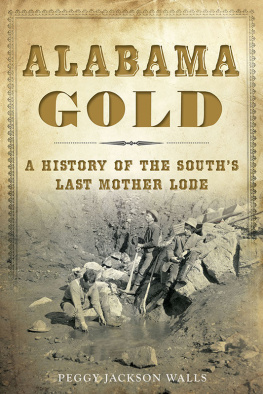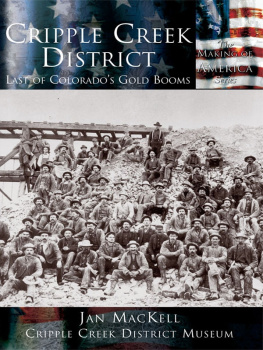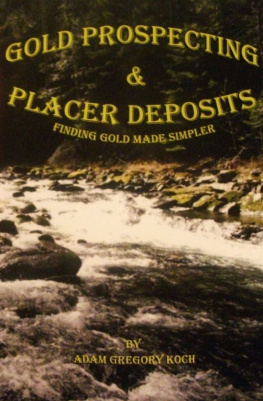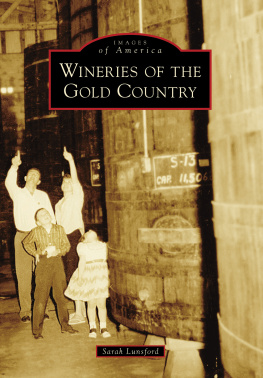

Published by The History Press
Charleston, SC
www.historypress.net
Copyright 2016 by Peggy Jackson Walls
All rights reserved
First published 2016
e-book edition 2016
ISBN 978.1.43965.661.7
Library of Congress Control Number: 2016931935
print edition ISBN 978.1.46713.598.6
Notice: The information in this book is true and complete to the best of our knowledge. It is offered without guarantee on the part of the author or The History Press. The author and The History Press disclaim all liability in connection with the use of this book.
All rights reserved. No part of this book may be reproduced or transmitted in any form whatsoever without prior written permission from the publisher except in the case of brief quotations embodied in critical articles and reviews.
Dedicated to the Hog Mountain gold miners whose stories made this book possible and especially to my father, Kermit Roosevelt Jackson (19091951).
Contents
Preface
In 1982, I began what would become a lifetime of researching, interviewing and writing about the Hog Mountain gold mine in northeast Tallapoosa County. Located less than three miles from my childhood home and rising four hundred feet from the surrounding landscape, the mountain was a daily, visible presence as familiar to my family as the sun rising in the east and setting in the west. I first learned the gold mining history of the mountain from conversations with family members and neighbors who worked for the Tallapoosa Mining and Milling Company in the 1930s. In school, I learned the geography and history of Tallapoosa County, where in the early 1800s, major battles took place between Native Americans and federal troops preparing the way for an influx of white settlers in the 1830s. But the Alabama history book contained no stories of Americas first gold miners, who traveled down the Appalachian Mountains into the foothills of Georgia and crossed into Alabama.
Gold within the Alabama gold belt counties lay beneath the soil of the old Creek Nation, similar to deposits in Georgia, mainly found under Cherokee land. The geography and the chronology of events suggest the presence of gold might have contributed to the agitation leading to the Indian Removal Act in 1832. Important events in Alabamas history were the Native American culture, the Indian Wars of 181314 and the shifting of power from the Native Americans to the federal government after the defeat of the Creeks at the Battle of Horseshoe Bend on March 27, 1814. Included in the major events were the sale of the Native Americans land to white settlers and the evacuation of Indians from their homeland to the West. During the march, which became known as the Trail of Tears, thousands of Native Americans died from starvation, disease and exposure to the elements. The Five Civilized Tribes, listed as the Creek, Choctaw, Chickasaw, Seminoles and the Cherokee, assimilated into the white mans way of livingresiding in cabins and growing vegetablesbut they were nevertheless banished from their ancestral lands.
As ownership of the land in east-central Alabama was shifting in 1832, gold mining was taking place. But miners failed to keep personal records of their activities, or those who might have had access to the records did not deem them important enough to be preserved. Journals and papers of early travelers in Alabama, detailed conversations and letters of the military leaders, Indian agents and Native Americans survived from this period. Although rich in data regarding the Indian wars, they contained almost nothing about gold mining. Any records from this period were embedded with other information. From these scattered sources, Alabama Gold constructs and shares the story of antebellum gold mining in Alabama.
The introduction summarizes the stories of Americas first gold discoveries in the southern Piedmont region: Cabarrus County, North Carolina; Lumpkin County, Georgia; and Chilton, Cleburne and Tallapoosa Counties in Alabama. The narrative reports of Alabamas first state geologist, Michael Tuomey, who served from 1848 to 1858, provide estimations of gold mines potential in the Alabama gold belt and descriptions of mining strategies employed by the miners and mining companies. The surveys are largely technical but offer observations on the frenzied, disorganized manner in which antebellum mining was conducted. They describe hillsides pocked with holes that miners dug in haste and abandoned when they failed to find ore quickly. Recorded also are brief conversations with prospectors and local people, knowledgeable about mining activities in their areas. Without the careful notes of geologists, only a negligible amount of information about gold mining in Alabama would exist.
With the encouragement of Judge C.J. Coley, Governor John Patterson, Dr. J. Wayne Flynt, Dr. Leah Atkins, Dr. Bert Hitchcock, Dr. Jerry Brown and Dr. Patrick Morrow, in the 1980s, I continued to research, write and promote the history of gold mining at Hog Mountain.
A great deal of my research was primary, having grown up near Hog Mountain, I was acquainted with gold miners who worked during the Depression. They were of my parents generation, and some were extended family. I found their stories fascinating and historically significant. I began with the goal of publishing an article about the Hog Mountain Mining and Milling Company operation. This goal was accomplished in the publication of Gold Mining at Hog Mountain in the 1930s in the Alabama Review of July 1984. The twenty-five or so, interviews I conducted at this time also provided material on which I developed my masters thesis, Folklore and Folk Life in Southern Prose Fiction, in which I linked Old Southwest humorist Johnson Jones Hoopers writing to life in the 1840s, when gold mining was at its peak in Tallapoosa County. In writing about stereotypical characters in southern fiction, I learned a few famous characters, such as Mark Twains King and William Faulkners Abner Snopes, might have had their genesis in the stereotypical con man Simon Suggs. Suggs was modeled after the frontier lawyer Bird Young, who was also an early settler of Youngsville, now Alexander City. The literary connections are interesting because the characters and stories that came out of the Old Southwest territory reemerged later in famous works of southern fiction. The story of antebellum gold mining is set in the Old Southwest, where danger was imminent due to hostilities between the white settlers and the Indians who viewed them as intruders on their land. During the early gold mining days, east-central Alabama was in transition from being the seat of the once powerful Creek Nation to embracing the early settlers and gold diggers. Alabama Gold tells the story of antebellum gold mining and the preCivil War culture. The preWorld War I and Depression-era operations were motivated by economic circumstances and the American dream that anyone who persistently works hard will be rewarded with success. Alabama Gold is a history of all the miners who busted and shoveled rock to, first, gain a foothold in the young state of Alabama and, last, to hold on to it through the Depression.
Acknowledgements
I want to begin with an acknowledgement of academic mentors and friends Dr. J. Wayne Flynt and Dr. Leah Atkins, who encouraged me to continue researching and writing long after I completed my graduate work at Auburn University and promoted my research in their published work. I also would like to recognize Dr. Bert Hitchcock, Dr. Jerry Brown, Madison Jones, Nancy Anderson and Dr. Patrick Morrow for their support and encouragement.
Next page










